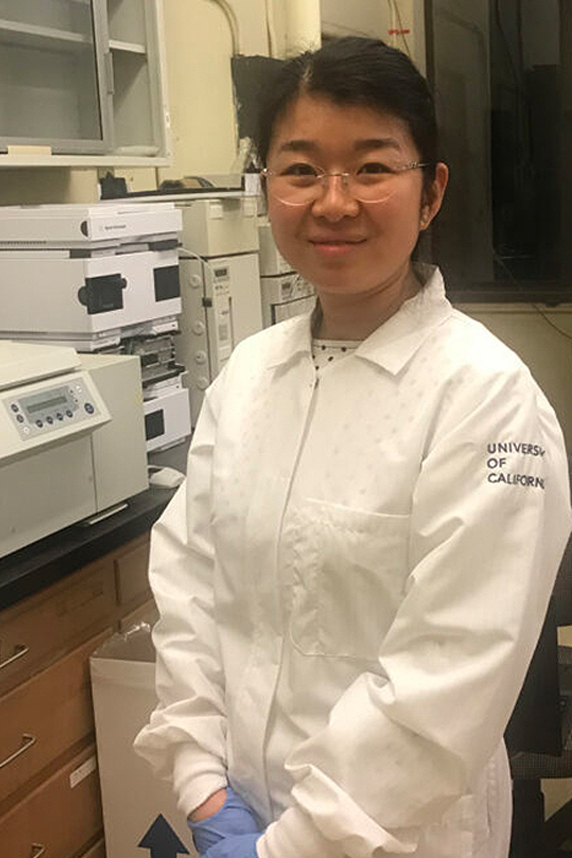A new NIEHS-funded study suggests that intestinal problems connected to obesity are associated with an enzyme known as soluble epoxide hydrolase (sEH).
Obesity has been linked to impaired function of the intestinal lining, which can allow bacteria and toxic bacterial products to move from the gut into the bloodstream and then into organs. This condition, often referred to as leaky gut, may result in systemic inflammation, insulin resistance, and other effects on the body.
 Hammock holds a joint appointment with the UCD Department of Entomology and Nematology and the Comprehensive Cancer Center. (Photo courtesy of UC Davis)
Hammock holds a joint appointment with the UCD Department of Entomology and Nematology and the Comprehensive Cancer Center. (Photo courtesy of UC Davis)Although impaired function of the intestinal lining underlies many human diseases, the mechanisms remain largely unknown. NIEHS grantee Bruce Hammock, Ph.D., led a team of researchers who inhibited sEH in obese mice. They observed that the absence of sEH improved intestinal function, curbed the movement of bacteria from the gut, and reduced inflammation.
Targeting enzyme effects
sEH is an enzyme in cells that degrades metabolites of fatty acids. Hammock’s lab studies sEH as part of his research with the University of California Davis (UCD) Superfund Research Program, which he directs.
To investigate factors that control enzyme activity and learn more about the role of sEH in detoxifying environmental chemicals, scientists created potent inhibitors. Over the years, Hammock has learned that blocking the function of sEH means that beneficial metabolites, like those from omega-3 fatty acids, are not degraded. Using these inhibitors, they are studying how sEH affects a variety of biological processes, including obesity-related illnesses.
Overexpressed in obesity
In the new study, the researchers found that sEH was overexpressed in the colons of obese mice compared with those of normal mice. Using potent sEH inhibitors, they found that blocking sEH abolished obesity-induced gut leakage, decreased movement of bacteria from the gut, and reduced inflammation in fat cells. These inhibitors are already in clinical trials for other human health disorders.
To explore the mechanisms by which sEH promotes gut leakage, the team treated normal mice with products of sEH metabolism. They observed reduced expression of proteins associated with regulating intestinal barrier function and increased levels of inflammatory proteins. These changes were followed by movement of bacteria out of the gut, accompanied by inflammation in the colon.
 Wang is the first author on the study, published in Proceedings of the National Academy of Sciences of the U.S.A. in April. (Photo courtesy of UC Davis)
Wang is the first author on the study, published in Proceedings of the National Academy of Sciences of the U.S.A. in April. (Photo courtesy of UC Davis)“Obesity usually causes the loss of tight junctions and leaky gut,” said first author Yuxin Wang, Ph.D., a postdoctoral researcher in the Hammock lab. “In normal conditions, the gut mucosal barrier is like a defender to protect us from the [so-called] dirty things in the lumen, such as bacteria and endotoxin. For obese individuals, the defender loses some function and leads to more bad things going into the circulation system, causing systemic or other organ disorders.”
A promising treatment
Previously, leaky gut treatments have targeted microbes, for example, by using antibiotics to reduce effects of bacteria. The authors suggested that instead, obesity-induced gut leakage could be treated by silencing the sEH enzyme in the body.
“To date, the underlying mechanisms of obesity-induced intestinal barrier dysfunction remain poorly understood,” said Guodong Zhang, Ph.D., from the University of Massachusetts. He is a former researcher in the Hammock lab and senior author of the new study.
“In this research, we showed that the effects of sEH are mediated by mechanisms that are dependent on gut microbiota,” he explained. “These research efforts could help to bridge two disparate fields, lipid signaling molecules and gut microbiota, and hold great promise for success to create an important new research area.”
Citation: Wang Y, Yang J, Wang W, Sanidad KZ, Cinelli MA, Wan D, Hwang SH, Kim D, Lee KSS, Xiao H, Hammock BD, Zhang G. 2020. Soluble epoxide hydrolase is an endogenous regulator of obesity-induced intestinal barrier dysfunction and bacterial translocation. Proc Natl Acad Sci U S A 117(15):8431–8436.
(Sara Amolegbe is a research and communication specialist for MDB Inc., a contractor for the NIEHS Superfund Research Program.)









